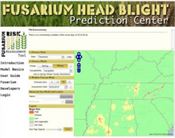|
Prevent Scabby Heads – Forecast For Fusarium Head Blight In Wheat
DR. HEATHER MARIE KELLY
JACKSON, TENN.
The wet weather we’ve been having is likely increasing Fusarium spores (inoculum) that can infect the wheat crop that is starting to head in most areas and develop into Fusarium Head Blight (FHB) or Head Scab.
FHB/Head Scab infection is favored by extended periods of moisture (3 or more days with frequent rainfall) or relative humidity (>90 percent) and moderately warm temperatures (between 59 to 86°F). These conditions present before, during, and after bloom favor spore production, flower infection, and colonization of developing grains. The Fusarium Head Blight Prediction Center (www.wheatscab.psu.edu) uses models to estimate Head Scab risk using weather variables observed seven days prior to flowering.
A note on the forecast website – it is best viewed with the following web browsers: Chrome, Firefox, and Safari (Internet Explorer has had some compatibility issues in the past). While evaluation of these models have shown them to be correct 75 percent of the time, it is still recommended to evaluate your local weather and wheat field as it approaches bloom to better guide fungicide application decisions.
While wheat is susceptible to infection from head emergence until harvest, infections initiated at and soon after anthesis have the greatest destructive potential. Research has shown the most effective timing for controlling FHB and mycotoxin levels is at initial bloom/flowering (Feekes 10.5.1), which relates to at least 50 percent of the heads blooming in a field. Although applications made 5 to 6 days after initial bloom can also provide a benefit in reducing FHB and mycotoxin levels. Applications made at earlier growth stages, such as flag leaf, do not provide control of FHB and mycotoxin levels.
Only fungicide products that are solo triazoles (FRAC or fungicide group 3 on the label) should be applied for prevention/management of Head Scab. Products that contain a strobilurin (FRAC or fungicide group 11) can increase the mycotoxin levels in FHB infected wheat. The best products currently available for reducing Scab symptoms and DON levels are Caramba and Prosaro. Although these fungicides, like all fungicides, are not going to provide 100 percent control, research trials have shown that FHB symptoms and DON levels can be reduced by approximately 40-60 percent relative to a non-treated check. Multiple factors contribute to this level of control which include fungicide efficacy, application coverage, timing in respect to wheat growth stage (all the heads in a field will not be flowering at the same time), and disease risk (i.e. weather before, during, and after application). A more comprehension fungicide table can be found at UTcrops.com (Wheat fungicide Table).
FHB/Head Scab not only reduces yields but the fungus can also produce mycotoxins, fungal chemicals that are harmful to animals if ingested. The major toxin associated with Scab is deoxynivalenol (called DON or vomitoxin). Wheat will usually be docked at DON levels of 2 parts per million (ppm) and loads can be completely rejected at 5 ppm. Another factor to consider, wheat planted behind corn has greater potential of FHB infection due to corn being a host for the pathogen.
The bottom line is that fungicides can reduce disease and DON levels, but pairing fungicide with a resistant variety will provide the best protection and both the FHB forecast model, along with your local forecast and information about your own field will better guide fungicide application decisions. ∆
DR. HEATHER MARIE KELLY: Extension Plant Pathologist, University of Tennessee

http://www.wheatscab.psu.edu/
|
|